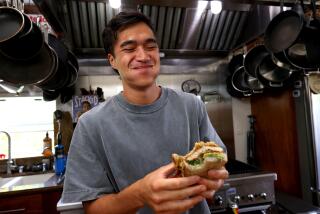Netflix’s ‘High on the Hog’ reveals how Black cooking is the bedrock of American food
The macaroni pie is ready, so steamy and golden you want to reach through the television screen to scoop up a big helping. Historian Leni Sorensen hovers over a kitchen hearth at Monticello, the Virginia plantation built by Thomas Jefferson. She uses a pot hook to remove the cast-iron lid and reveal the casserole dish inside the baking vessel. “Oh, it’s sizzling,” she says, the sound audible in the background like distant applause.
Then the camera zooms in on a sight familiar to generations of Americans: grated orange cheddar melted into a glossy blanket over tube-shaped pasta. “It’s beautiful,” says Stephen Satterfield, the host of the limited series “High on the Hog: How African American Cuisine Transformed America,” debuting today on Netflix.
Cooking the late-1700s-era recipe comes in the third of the show’s four episodes, which focuses on contributions of the chefs enslaved to the earliest presidents of the United States. They include Hercules (sometimes known as Hercules Posey), who cooked for George Washington, and James Hemings, whom Thomas Jefferson sent to France for training. Hemings perfected the recipe for what so many of us know and love today as mac and cheese. When bartering successfully for his freedom, Hemings wound up training his younger brother Peter to take over his responsibilities. Historical records can trace how a lineage of cooks from Jefferson’s kitchens spread throughout the growing nation, circulating Hemings’ base of knowledge.
A quick online search turns up plenty of articles detailing Hemings’ connection to mac and cheese. But in the context of the series, the reality of its origins reaches viewers with a fresh, saturating clarity.
It’s the strength of the medium. “High on the Hog” is a revolutionary moment for American food and travel television programming. It has the come-hither trademarks of the genre — the fascinating glimpses into regional and international cultures, the sweeping cinematography of, say, South Carolina coastline and dusty Texas trails, the shots of shrimp sputtering in oil on the stove and barbecued beef being sliced slo-mo into lush slivers.
The difference lies in the piercing axiom that drives the series: The roots of our national foodways stem from Black hands and minds. Mapping that veracity fills the beautiful, absorbing and sometimes painful frames.
The show takes its name — and its blueprint — from the invaluable 2011 book by scholar and cookbook author Jessica B. Harris. Her “High on the Hog: A Culinary Journey From Africa to America” weaves academic research with personal narrative, tracking foods of the African diaspora and positioning the ways that Black cooking traversed class and often fueled enterprise throughout our fast-evolving history.
Both the book and the series open at the Dan-Tokpa Market in Cotonou, Benin, the small West African country that was once a major departure point for the transatlantic slave trade. Harris joins Satterfield in this first episode. The food stalls hold up mirrors to their American diets: They remark on bushels of okra, banter about the differences between yams and sweet potatoes and linger over various shades and textures of rice. They share a lunch in which pepper sauce makes the meal. The two of them visit scenes of past horrors and meet strangers for a meal that feels remarkably like a reunion.
In a moving ending to the episode that I’d rather urge you to watch than recount here, Harris all but passes a literal baton to Satterfield, sending him back to America to follow the narrative ripples that their time in Benin sets in motion.
Satterfield has worn many hats: chef, sommelier, journalist and, in his current day job, a founder of Whetstone Media. He is a natural onscreen. Charismatic and inquisitive, he also shows a remarkable ability to hold emotional space for the chefs, writers, farmers and other tradespeople (hello, Texas cowboys) as they relate their tales. You see it in his eyes. He isn’t simply a personality ushering you along on a journey; he’s personally invested in this effort to reclaim and clarify Black culinary identity.
He’s also brilliant at describing dishes: You want to be sitting next to him as he talks through his first sip of Bellevue broth in Philadelphia or samples Jerrelle Guy’s Juneteenth-inspired raspberry-hibiscus cheesecake in Houston.
For Satterfield, his participation in “High on the Hog” is another facet of his mission to reframe ownership of history and recast the chroniclers.
“I can’t even begin to speculate what the show’s impact will be,” he says, “but I can tell you that had it not been for food media, I would not be here. The Food Network, Jacques [Pepin], Julia [Child], Martha Stewart: Consuming this kind of media was so formative that I decided as a teenager to dedicate the rest of my life to food. Now we have a whole generation of Black youth who are going to see this program. I know how high the stakes are.”
Satterfield also said yes because of the Black creators involved, including Los Angeles-based executive producers Karis Jagger and Fabienne Toback, Academy Award-winning director Roger Ross Williams, film director Yoruba Richen and producer Jonathan Clasberry, who counts “Anthony Bourdain: Parts Unknown” among his credits.
“Why does this team matter? Because stories are central to power,” Satterfield says. “People who don’t have power are written out of the story, which is why we could get all the way to 2021 and say, why haven’t we seen this story about macaroni and cheese told this way on television before? We have the opportunity for the first time to tell our own story in our care. It’s rare and powerful.”
Harris left many threads for the producers to follow. “The themes are so strong in the book: survival, self-reliance, entrepreneurship, connectivity,” Jagger and Toback conveyed through a joint email. “There were stories we gravitated to in the book that we were really attached to and felt were necessary to the series: Carolina Gold Rice, Hercules Posey, James Hemings, the catering families of Philadelphia, Thomas Downing. … We wanted to interweave history, modern influences and locations in forming the narrative structure.”
They succeed, but Harris also cleared paths for them to Chicago; to New Orleans; through Prohibition to the civil rights era; to immigrants with African heritage from the Caribbean, Central and South America; and to other cultural crossroads via Africa.
During a meal filmed for the show in Philadelphia, chef Omar Tate notes that “a lot of times our history is dark ... but there is so much beauty between the lines.”
The four episodes of “High on the Hog” is an incredible, belated start to floodlighting the achievements of Black culinarians. This limited series could — should — be endless.
More to Read
Eat your way across L.A.
Get our weekly Tasting Notes newsletter for reviews, news and more.
You may occasionally receive promotional content from the Los Angeles Times.










